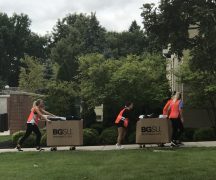In the month since the Ohio Department of Health issued a mask requirement in the state, the spread of COVID-19 has dropped by more than 31%, as measured by a seven-day moving average of new cases.
Interim Director of Health Lance Himes signed an order requiring Ohioans to wear masks in non-residential indoor locations and certain other sites on July 23.
About 1,370 Ohioans were infected on average per day at the time, according to an analysis of new cases reported by day from ODH.
As of Tuesday, Ohio is reporting about 939 cases per day, measured by seven-day moving average.
(Measuring newly reported cases by day runs higher than cases by illness onset datebecause the former contains older cases that were newly detected. However, the newly reported case numbers can be used to measure old data more accurately against current data, which lags by a week or two.)
The finding supports the conclusion drawn by researchers and repeated by public health officials that wearing face masks is a low-cost and effective tool to slow the spread of COVID-19.
The recent ebb after a surge of cases in July is reflected in a sharp drop-off in patients hospitalized with COVID-19, and a more subtle slowdown of coronavirus deaths.
“While we can’t prove that the mask mandate was the cause of the decline in cases, there is strong evidence from CDC that wearing masks and social distancing helps prevent the spread of COVID-19,” said ODH spokeswoman Melanie Amato.
“After the mask orders went into effect (originally in the red counties), cases began to level off and eventually decline.”
Science
According to guidance from the CDC, wearing a mask may keep the wearer from spreading the virus to others.
The underlying theory holds if enough of a population wears masks — in tandem with social distancing, hand hygiene and other preventative measures — communities can wrangle the virus under control.
The CDC estimates about one-third of COVID-19 cases come without symptoms. People can also shed the virus before symptoms kick in, all complicating policy responses.
In June, researchers gathered data on 26,000 patients from 172 observational studies across 16 countries on six continents. Their findings, published in The Lancet, determined face mask use could result in “a large reduction in risk of infection.”
Another study published in the Journal of Medical Virology in March found even homemade masks can block more than 95% of the virus in aerosols emitting from the mouth of a potential wearer.
An April study published by the American Chemical Society found combinations of various, commonly available fabrics can “potentially provide significant protection” against the transmission of aerosol particles.
“It is apparent that many people with [coronavirus] infection are asymptomatic or presymptomatic and that these people account for a substantial fraction of all transmission,” researchers wrote in the New England Journal of Medicine.
“Universal masking helps to prevent such people from spreading virus-laden secretions, whether they recognize that they are infected or not.”
The case decline in Ohio mirrors a similar trend at the national level. The Associated Press reports most states — even those with governors who waged public fights against face coverings — now have mask mandates in place, either through statewide orders or patchwork efforts by state and county.
Politics
Since Ohio’s first reported cases in March, masks were a political problem.
Initially, federal health authorities advised against facial coverings, citing high demand and short supply of masks for medical personnel.
Their tune changed in April as the science behind masks developed. Ohio’s Republican political power, meanwhile, dug its heels in against masks.
Republican state lawmakers, who have firm control of both chambers, refused to wear them personally. The Ohio House voted down a requirement that lawmakers and staff wear them in the Statehouse. Some explicitly campaigned against mask, challenging their efficacy and questioning the motives of their advocates.
Around the same time, President Donald Trump and Vice President Mike Pence made public showings of their refusal to wear masks as well, even when touring a mask factory and military hospital, respectively.
Gov. Mike DeWine originally announced a mask mandate in April and abruptly reversed himself the next day . He attributed the 24-hour about face to learning how “offensive” people (and the politicians who bent his ear) found a government order requiring that they wear masks.
By early July, smaller cities like Bexley and Yellow Springs, shortly followed by Dayton,imposed mask ordinances of their own in the face of state inaction.
Citing increased levels of spread, DeWine ordered mask mandates on seven of Ohio’s most populous counties (Butler, Cuyahoga, Franklin, Hamilton, Huron, Montgomery and Trumbull) on July 7.
Backing up the governor, Cleveland (July 3), Columbus (July 7) and Cincinnati (July 9) passed orders of their own.
When DeWine issued the mandate in the midst of a massive new case surge, a reporter asked whether he wished he had issued the mandate earlier.
“[I] felt that masks would make a difference, also knew that there was significant of resistance in Ohio,” DeWine said in response. “[I was] kind of wanting to bring Ohioans along on this journey. That’s what a governor does. A governor has to lead, but a governor also has to bring people along.”
***
‘Extremely frustrating’ mail delays for prescriptions hit veterans, rural areas
Jan Stowe, a Vietnam War veteran from Traverse City, Mich., says she was unable to move her head and neck for several days last month after going without medication to treat extreme muscle spasms.
Stowe, a Department of Veterans Affairs patient who receives her medication through the U.S. Postal Service, said in an interview with States Newsroom that she missed four or five days taking her prescription for diazepam, commonly marketed as Valium, because of mail delays.
Without the drug, her movement was restricted, and she started experiencing withdrawal symptoms, she said. It wasn’t life-threatening, she said, “but it was life-altering.”
“It’s not life-saving,” she added. “It’s not like insulin, or heart medication or anything like that. But it was just extremely frustrating and uncomfortable.”
Stowe is not alone. Veterans, people who require specialty medications, rural residents far from pharmacies and others who receive their prescription medications through the Postal Service say they have experienced delays and other delivery disruptions after the Trump administration made changes to post office operations. READ MORE
DeWine says his administration wants ideas about how to help distressed Ohioans
During a press conference that was again dominated by talk of bar curfews, youth sports and the return to college, Ohio Gov. Mike DeWine on Tuesday said his administration is taking several steps to help poor and minority Ohioans — the group that is getting coronavirus at disproportionate rates and is bearing the brunt of the economic fallout.
But the governor added that he’s open to ideas.
“We continue to see a difference in the COVID; its impact on African Americans, its impact on Hispanics,” DeWine said.
It’s been almost a month since a $600-a-week federal unemployment supplement and an eviction moratorium both expired. Both expirations are expected to leave many of the 503,000 Ohioans who were unemployed in July in harrowing economic circumstances — even as they, their families and their friends are more likely to get the disease. READ MORE
Commentary: Educators battle misinformation in run-up to November election
We are living in the age of fake news. No, not the “deep state is out to get the president” kind. The real “fake news” is all around us, spreading partially by word of mouth and at certain political rallies, and much more so on Facebook and Instagram, as people pass along rumors and myths that fit their world view.
So what?
Well, for one thing, it is frustrating. As educators, we teach facts — the laws of physics, the branches of government, grammar rules, math formulas — things that don’t change, no matter how you feel about them. More importantly, we teach critical thinking. It is a reflection of the era in which we live that the children in our classrooms can separate fact from fiction better than some adults.
The widespread misinformation circulating among adults is threatening the foundation of our democracy. There is a chance a considerable number of Americans will not vote in the coming election or will cry foul over the results because of lies they have read online. READ MORE





